Stepping foot onto the sun-soaked shores of Barbados, one is immediately embraced by a welcoming blend of tantalizing aromas and mouthwatering flavors. This Caribbean island, often referred to as the “Culinary Capital of the Caribbean,” has a vibrant food culture that’s as rich and varied as its history.
Bajan food, as it’s locally known, provides an exciting journey into the island’s past, revealing a tapestry of influences, from its early roots in slavery to its modern-day global connections.
From Slavery to Savory: Early Origins of Bajan Cuisine

A deep dive into Bajan cuisine’s history necessitates a look back to the days of the Transatlantic Slave Trade. In the 17th century, Barbados was one of the largest sugar producers, and the slave population introduced by the British significantly impacted the food culture. The enslaved Africans had to make do with the food provisions they were given – usually the less desirable cuts of meat and offal, root vegetables, and tropical fruits.
From these limited resources, they created meals that were not only nourishing but flavorful, laying the foundation for the rich culinary tradition we see today.
One such dish is “Pudding and Souse,” a Saturday staple in Barbados. Originally made from the leftover parts of the pig, this dish illustrates the ingenious culinary adaptations of the enslaved Africans. The pudding is a combination of sweet potato and pig’s blood, while the souse is made from pickled pig parts, such as the feet, ears, and snout. This might seem strange to some, but its blend of flavors, textures, and spices is a true testament to the resilient spirit of the Bajan people.
Caribbean Crossroads: Interweaving of Cultural Influences
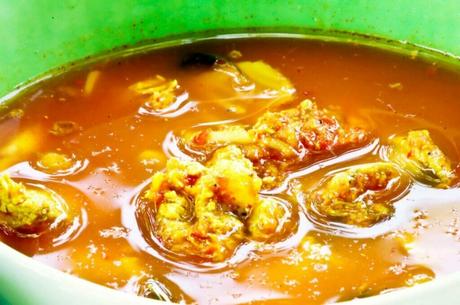
Over the years, Barbados has been a cultural melting pot, and this diversity is reflected in its cuisine. The indigenous Arawaks contributed methods of food preservation, such as smoking and salting fish. European settlers introduced bread, cheese, and livestock, which significantly expanded the Bajan diet. Post-emancipation, indentured laborers from India brought their rich flavors and spices, birthing Bajan dishes like roti and curry.
Another key influence on Bajan cuisine is the sea. Barbados is surrounded by the Atlantic Ocean, and its rich marine bounty has shaped the island’s food culture. Flying fish, for instance, is a national symbol of Barbados and a key ingredient in the famous Bajan dish, “Cou-Cou and Flying Fish.”
Modern-Day Bajan Cuisine: Global Flavors, Local Roots
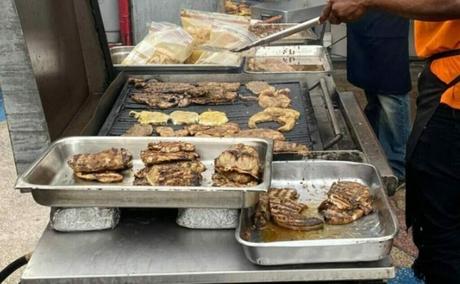
Today, Bajan food continues to evolve, absorbing influences from around the globe, while maintaining its distinct local flavor.
International cuisines, fast food chains, and gourmet restaurants coexist with traditional food stalls, rum shops, and fish fries, creating a dynamic and vibrant food scene.
Barbados Travel Tip: We simply can’t write about Bajan cuisine without mentioning the beloved national pastime – the Oistins Fish Fry.
Every Friday night, locals and tourists alike flock to this south coast fishing village for an authentic Bajan experience. Underneath the starlit sky, the air fills with the smoky aroma of grilled fish, while the sounds of calypso and reggae music set the rhythm for the night.
Bajan Food as Cultural Expression: The Role of Festivals and Celebrations
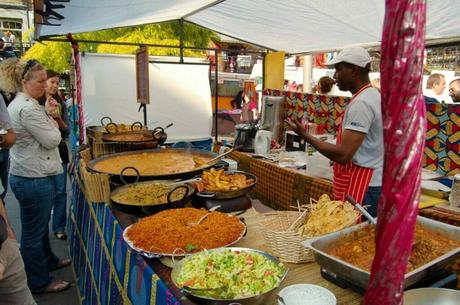
The celebration of Bajan food is not limited to homes and restaurants. It spills over into the streets and public spaces, with numerous food festivals and events held throughout the year.
These festivals are not just about gastronomy; they are a cultural expression, a way of celebrating the island’s history, and the role that food has played in shaping Barbadian society.
The Food and Rum Festival is one such event that has gained international acclaim. This culinary extravaganza brings together local and international chefs to showcase the versatility and depth of Bajan cuisine.
Visitors get a chance to sample everything from traditional Bajan dishes to innovative culinary creations that blend local ingredients with global cooking techniques.
Iconic Bajan Dishes

When exploring Bajan cuisine, certain dishes stand out due to their cultural significance, unique flavors, and the stories they tell about Barbados’ history.
These iconic dishes, steeped in tradition, offer a genuine taste of the island’s culinary heritage. Let’s delve into a few of them:
- Cou-Cou and Flying Fish: As the national dish of Barbados, this meal showcases the island’s bountiful sea and the African influence on its cuisine. Cou-Cou, similar to polenta, is made from cornmeal and okra, while the flying fish is usually stewed and served in a rich tomato sauce.
- Macaroni Pie: Often referred to as the Caribbean version of mac and cheese, this hearty dish is a staple at family gatherings and celebrations. Made with macaroni, cheese, and various seasonings, it’s typically baked to achieve a deliciously crispy top layer.
- Rice and Peas: A classic across the Caribbean, this dish is a testament to the African and Asian influences on Bajan cuisine. The “peas” are actually beans, often pigeon peas or black-eyed peas, cooked with rice in coconut milk for a creamy, flavorful side dish.
The Story Behind the Spices: A Look at Bajan Seasoning
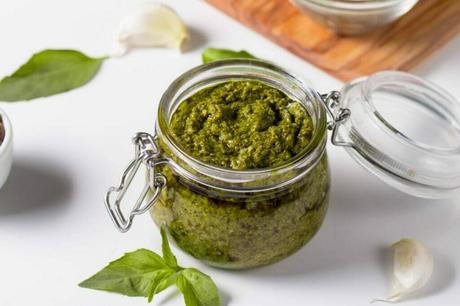
The flavors of Bajan cuisine are brought to life by the unique blend of herbs and spices used in their preparation. Bajan seasoning, a potent mix of fresh herbs, hot peppers, onions, garlic, and lime juice, forms the backbone of many dishes. This aromatic blend is a legacy of the island’s rich cultural tapestry, with each ingredient telling a story of migration, adaptation, and culinary evolution.
Street Food – A Slice of Everyday Bajan Life
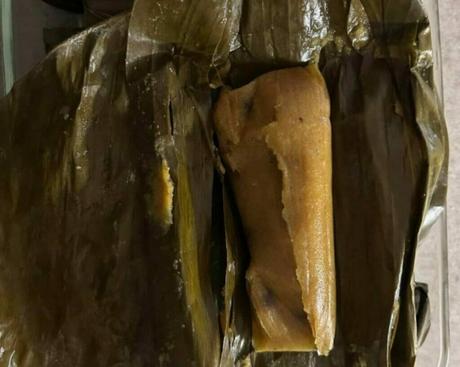
For a true taste of everyday Bajan life, a stroll through the bustling streets of Bridgetown offers a myriad of culinary delights. From the ubiquitous ‘cutter’ sandwiches, a Bajan take on the classic sandwich filled with ham, cheese, or fish, to ‘Conkies’, a traditional dish made from cornmeal, coconut, pumpkin, and sweet potatoes wrapped in banana leaves, street food in Barbados provides an authentic gastronomic experience.
Influence of Agriculture
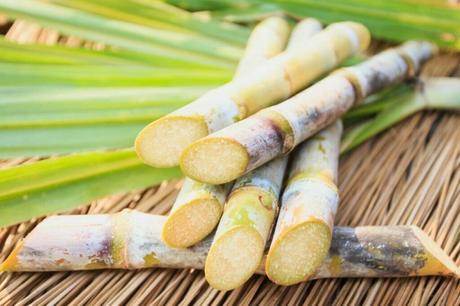
Barbados’ agricultural landscape has had a profound impact on its food culture. As we trace the evolution of Bajan cuisine, it’s essential to understand the role of traditional crops and farming practices. Here are some key agricultural influences:
- Sugarcane: Introduced by the European settlers, sugarcane not only shaped the island’s economy but also its cuisine. It led to the creation of Barbados’ world-renowned rum and influenced many sweet treats like sugar cakes and tamarind balls.
- Root Vegetables: Indigenous root crops like yams, sweet potatoes, and cassava were dietary staples for the island’s early inhabitants. These hearty vegetables continue to feature prominently in Bajan cuisine, in dishes like Pudding and Souse and Conkies.
- Tropical Fruits: The island’s tropical climate allows for a wide variety of fruits like mangoes, guavas, and passion fruits. These fruits are eaten fresh, used in desserts, or transformed into jams and jellies, adding a sweet touch to the Bajan food palate.
FAQ
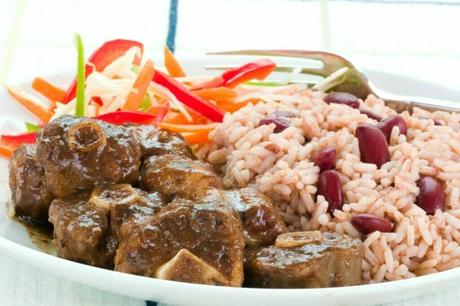
What Is Typical Bajan Food?
Bajan food, or Barbadian cuisine, is a unique blend of African, Indian, Irish, Creole, and British influences. Typical dishes often feature fresh, locally sourced ingredients such as fish, pork, poultry, yams, and tropical fruits, combined with a rich array of herbs and spices. Signature dishes include Cou-Cou and Flying Fish, Pudding and Souse, and Macaroni Pie.
What Is The Traditional Meal Of Barbados?
The traditional meal of Barbados is Cou-Cou and Flying Fish. This iconic dish represents the island’s African heritage and its rich marine resources. Cou-Cou is made from cornmeal and okra, while the flying fish is usually stewed in a savory tomato-based sauce, creating a harmonious blend of flavors.
Is Bajan Food Spicy?
While Bajan food is full of flavor, it is not typically characterized as overly spicy. However, many dishes are seasoned with a unique blend of herbs and spices, known as Bajan seasoning, which provides a robust flavor profile. Hot pepper sauce is also a popular condiment, allowing individuals to adjust the level of heat to their preference.
What Food Is Popular In Barbados?
In Barbados, the popular foods are often those deeply rooted in the island’s history and culture. These include the national dish, Cou-Cou and Flying Fish, as well as Pudding and Souse, Macaroni Pie, and Rice and Peas. Street food, such as the ‘cutter’ sandwiches and fish cakes, are also crowd favorites among locals and tourists alike.
What Do Bajans Eat For Breakfast?
Bajan breakfasts typically consist of hearty, filling dishes. Common options include salt bread filled with cheese or ham, known as cutters, or cornmeal porridge. On weekends, a more substantial breakfast might include Buljol (saltfish salad), fried plantains, eggs, and Bakes (fried dumplings).
What Are Bajans Known For?
Bajans, or Barbadians, are known for their vibrant culture, warm hospitality, and rich culinary traditions. The island’s food culture, particularly its iconic dishes like Cou-Cou and Flying Fish, is renowned worldwide. Additionally, Barbados is famous for its rum, with the island often referred to as the birthplace of this spirit.
Bajan Food Recap: The Taste of Barbados, Past and Present
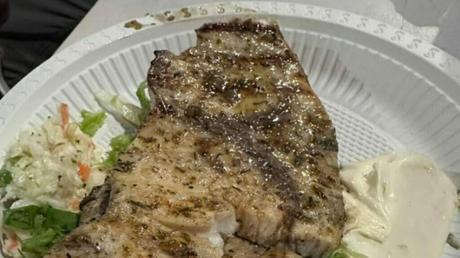
Bajan cuisine is a delicious testament to the island’s historical journey. Its flavors tell tales of resilience, creativity, and cultural fusion, providing a unique way to explore Barbados’ heritage.
As you delve into the depths of its culinary delights, you’re not just tasting food; you’re experiencing a piece of Bajan history.
Whether you’re sampling the rich pudding and souse, savoring a bite of cou-cou and flying fish, or enjoying the communal spirit at Oistins Fish Fry, you’re partaking in a centuries-old tradition that continues to shape the island’s identity.
So, let your taste buds lead the way and embark on a journey that offers a deliciously rich understanding of Bajan food, culture, and history.

